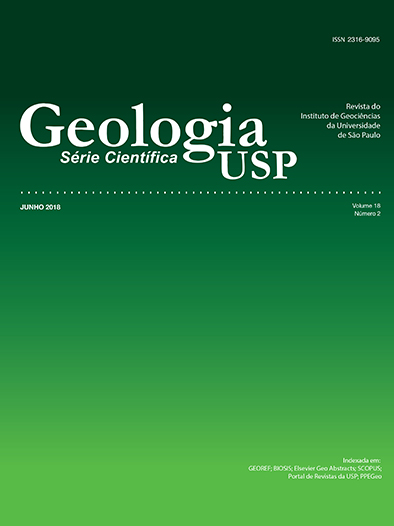As raízes granulíticas do cinturão Salvador-Esplanada-Boquim, Cráton do São Francisco, Bahia-Sergipe, Brasil
DOI:
https://doi.org/10.11606/issn.2316-9095.v18-134238Palavras-chave:
Granulito, Geoquímica, Geocronologia, Cinturão Salvador-Esplanada-Boquim.Resumo
O Cinturão Salvador-Esplanada-Boquim (CSEB) é provavelmente um ramo nordeste do Orógeno Itabuna-Salvador-Curaçá. Neste trabalho, inédito para a região, é apresentada a caracterização petrográfica, petroquímica e geocronológica preliminar das rochas granulíticas da porção central-norte desse cinturão, onde foram separadas quatro unidades granulíticas ácidas e intermediárias, além de bandas de granulitos máficos, granulitos aluminosos e quartzitos. As quatro unidades ácidas e intermediárias são ortogranulitos foliados onde os granulitos máficos encontram-se encaixados sob a forma de lentes. Essas rochas foram atravessadas por diques orosirianos, dacíticos-riolíticos (Diques de Arauá). O estudo litogeoquímico dos granulitos ácidos e intermediários revelou quatro séries cálcio-alcalinas de baixo a alto K, assim denominadas: enderbítica (Ed1), enderbítica (Ed2); charnockítica de composição monzogranítica (MCh) e charnoenderbítica (Ch-Ed). Diagramas multielementares indicam que as quatro unidades possuem anomalias negativas de Nb, Ti e P e baixos teores de high field strenght elements (HFSE), sugerindo haver associação genética ligada a zonas de subducção e arcos vulcânicos. Os granulitos máficos, por sua vez, apontam para uma filiação toleítica com características tipo island-arc tholeiite (IAT). Os dados geocronológicos indicam idades que sugerem a presença de eventos tectônicos ocorridos na área, a saber: formação do protólito do granulito (Ed2) em 2,90 Ga (idade-modelo TDM-Nd); cristalização do granulito (Ed2) em 2582 ± 11 Ma e do MCh em 2473 ± 13 Ma; metamorfismo regional com idades entre 2087 e 2073 Ma; e preenchimento de falhas em forma de diques em torno de 2015 ± 12 Ma. Os dados obtidos, sobretudo aqueles da litogeoquímica, estão permitindo interpretar que essas rochas metamórficas de alto grau se adequam àquelas do tipo arco vulcânico. Essas, ao colidirem no Paleoproterozoico com o Bloco Serrinha, situado a oeste da área estudada, formaram uma cadeia de montanhas, a qual, ao ser erodida, expôs suas raízes granulíticas.
Downloads
Publicado
Edição
Seção
Licença
Autores que publicam nesta revista concordam com os seguintes termos:
- Autores mantém os direitos autorais e concedem à revista Geologia USP. Série Científica, o direito de primeira publicação, com o trabalho sob a licença Creative Commons BY-NC-SA (resumo da Licença: https://creativecommons.org/licenses/by-nc-sa/4.0 | texto completo da licença: https://creativecommons.org/licenses/by-nc-sa/4.0/legalcode) que permite o compartilhamento do trabalho de forma não comercial e conferindo os devidos créditos autorais da primeira publicação nesta revista.
- Autores têm autorização para assumir contratos adicionais separadamente, para distribuição não-exclusiva da versão do trabalho publicada nesta revista (publicar em repositório institucional ou como capítulo de livro), conferindo os devidos créditos autorais da primeira publicação nesta revista.
- Autores têm permissão e são estimulados a publicar e distribuir seu trabalho online (em repositórios institucionais ou na sua página pessoal) a qualquer ponto antes ou durante o processo editorial, uma vez que isso pode gerar alterações produtivas, bem como aumentar o impacto e a citação do trabalho publicado (Veja O efeito do Acesso Aberto e downloads no impacto das citações).














